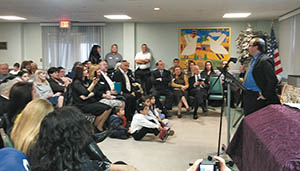


How do you find a particular Goldberg out of all the Goldbergs in America? Just ask Jerry Schranz, Fair Lawn resident, who tracked down the family of Gershon Goldberg in anticipation of restoring a Torah once dedicated in his memory. Schranz also located descendants of Samuel Kossman, again in preparation for a Torah re-dedication ceremony recently held in Paterson.
The hachnasat sefer Torah, held at the Torahs’ home at the Federation Apartments, celebrated the restoration of these two decades-old Torahs dating back to the 1920s and 1950s. Federation Apartments received the Torahs as a donation from Yavneh Academy when the school moved out of Paterson in 1982.
With the scrolls having fallen into disrepair, Schranz took it upon himself to locate the families and find donors to help restore the Torahs. The accomplishment was celebrated with the hachnasat sefer Torah attended by residents, local seniors, families of the original donors, nearby community rabbis from Fair Lawn, and other friends and supporters, filling a room with well over one hundred people on November 29.
Of the Torah donated in memory of Kossman, Schranz said, “Goldie Kossman is 100 years old, living in Florida. She helped me find others, including her grandson Chaim Sussman, who currently lives in Teaneck.”
Schranz jokingly said of the second Torah, dedicated in memory of Goldberg, “There’s a lot of Goldbergs in this world,” but people from Yavneh were able to point him in the right direction. Direct descendants and siblings Sharon Cohen, Judy Goldrich, and Gersh Goldberg (who is named after the Gershon Goldberg for whom the Sefer Torah was originally dedicated in 1926) were emotional upon hearing from Schranz that the Torah had been located. Goldrich and her family attended the celebration and she shared the story of the Torah.
“My grandmother, Chaya Goldberg, dedicated the Torah in memory of her husband Gershon,” she said. Her father, David, used to read from the Torah. “It was later housed at Yavneh where I and many members of my family attended. When Yavneh moved to Paramus, the family lost track of it—no one seemed to know where it was.”
Her father, David Goldberg, had passed away, and her mother couldn’t remember what the cover’s design looked like so wasn’t sure how to describe it to others. The family tried asking multiple people, but no one seemed to know whether it was still in the old building, in storage in the new one or elsewhere.
Tears came to Goldrich’s eyes as she recalled what came next. “In the last years of her life, my mother asked her kids to find the family sefer Torah—but she died in 2009 and we still couldn’t. And then, one day last spring, we heard from Jerry.”
The Goldbergs were delighted to hear that their sefer Torah was being used again, and even ordered a new mantel with the names of all their family members decorating the cloth. At the hachnasat sefer Torah, as Judy pointed out, it was the first time in over 35 years that members of the Goldberg family were reunited with the Torah. In a few weeks, another David, Judy’s son, will be borrowing the sefer Torah to read from at his aufruf, bringing the history of this Torah full circle.
The Kossman Torah also received a new mantel, and Schranz reached out to the head of Yavneh to select students to help choose the design, in order to continue the former close connection between the school and the Torah scroll.
Rafael Hirsch, a sofer (Torah scribe) who resides in Bergen County, was tasked with accomplishing the repairs. He also spoke at the event and discussed the challenges these old scrolls presented in their repair.
“The fact that a sefer Torah is fifty, sixty, even seventy years old,” he said, “does not make it any less sacred.” It took him over a month to finish each one, with progress sometimes slowing to one column per 8-10 hours in areas where a lot of repairs were needed. Ultimately, Hirsch said, “It was my privilege to be the instrument to restore these sifrei Torah to active duty.”
Paterson was once a thriving Jewish community, and the impact of its history remains with the community’s descendants. “This shul has brought back a lot of people,” Schranz said. “I feel like [this project] opened up a time machine.”
By Leah Gottheim









